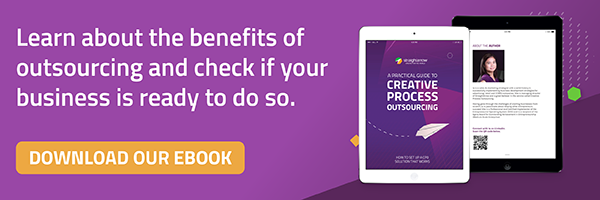![So You’ve Decided to Outsource: Now What? [Infographic]](https://www.straightarrow.com.ph/hs-fs/hubfs/2016_Images/September_2016/So_Youve_Decided_to_Outsource.png?width=685&name=So_Youve_Decided_to_Outsource.png)
Take some time, first of all, to appreciate where you are. You’ve made a decision—and as any Hamlet can attest, decisions aren’t easy—and what’s more, it’s a decision that will significantly shape your business’ trajectory. How exactly it shapes it, however, depends on how you follow through.
Figuring out how to start outsourcing might be a little overwhelming at first. Maybe you’re not sure where to start looking. Or maybe you already know a few potential providers, but aren’t sure which one to pick. Or it could be that you’ve already come up with your short list, but you’re having second thoughts—after all, there’s a dozen other ways you could be doing this.
So, back to our initial statement: if you find yourself at a loss, take a step back. You begin outsourcing by looking in.

Step 1: Know Your Needs
There’s a good chance you’ve already gone through this, but it never hurts to be sure—and with this here, you can go back to it later—but before you start on your outsourcing, you should be able to communicate precisely what you need. In other words, you should be able to describe the following:
-
What your company is: its mission, vision and values.
-
What your product or service is: what it does better or does differently.
-
What’s missing from it: the specific tasks you need to outsource, such as web development, graphic design, content marketing, and so on.
-
How you want it done: communication, quality assessment, turnaround times, payment schemes and everything in between.
You know you’ve got this covered when you can discuss those points easily, whether you have to do it in a minute or for an hour.
Step 2: Search for Sources
No one outsources without sources, so once you’ve ascertained your needs, start scouring the market for providers who fit your criteria.
Personal or corporate networks are a good start, considering that no matter who you hire through this method, it’s likely you know someone who can introduce you or even vouch for their work. Social media, especially LinkedIn, can be useful platforms when taking this approach.
On the other hand, you might begin your search by looking for examples of work you like and looking up the people or agencies behind it. When you find them, let them know you’re looking to outsource work—you never know who’ll be up for it until you try.
You can also start by choosing an outsourcing “destination.” Different countries have different benchmarks in terms of pricing, linguistic and technical competency, and, of course, culture. If you can identify a country whose profile matches your requirements, you can narrow down your search for a specific provider. For instance, you can check to see why so many companies choose the Philippines as an outsourcing destination.
While looking for providers, you’ll have two broad options: enlisting individual freelancers or contracting with an agency. There are pros and cons to each, and which one you choose will vary according to your requirements and management style. Teams of freelancers require more effort and management, but the market can’t be beat in variety. Agencies, on the other hand, have stability and a range of readily available resources. If you’re on the fence, here's what creative outsourcing agencies can bring to the table.
Whichever approach you take, and whether you prefer freelancers or agencies, keep everything from Step 1 firmly in mind. These will help you narrow down your search even before moving on to the next step.
Step 3: Test the Waters
You can start to get a feel for a potential provider even from the first few moments of contact. Pay attention to how well they’ve read your posting or job order, and how they pose or respond to questions. Outsource providers who jump at any job, ignoring the details in the posting, should be met with skepticism. On the other hand, providers who can answer your questions well, or raise insightful questions of their own are probably worth shortlisting.
Don’t give a prospect the go-ahead until you’ve identified at least a few alternatives. As a rule of thumb, have two to four prospects shortlisted and reevaluated before settling on any freelancers or agencies.
It’s also a good idea to carry out a pilot project with your prospects, whether you’ve settled on one finalist or still have a shortlist you’re paring down. A good pilot project is one that is relevant to the task you’ll eventually be outsourcing, and also one that can be scaled up. Even better are tasks you’ve done in some form before, so that you can compare results. Pilot projects aren’t free, though, so don’t proceed to this step unless the prospects show serious promise.
Step 4: Clarify and Commit
If your prospective partner impresses at every turn, then you’re ready to lay the groundwork for your collaboration. A good agreement is founded on priorities and specificity. Be clear about your non-negotiable requirements, but make sure your outsource supplier has enough room to flex their expertise—it’s what you should be enlisting them for, after all.
Make sure to agree on the following points:
-
Tasks and/or processes to be outsourced: Including process flows, accountabilities, and estimated turnaround time
-
Resources required: in terms of skills, tools, and other material resources
-
Costs and terms of payment
-
Other important issues like intellectual property rights and degrees of confidentiality
Then put it in a formal agreement for both sides to sign. Once that’s done, hand the reins over to your new collaborators so you can go back to focusing on the aspects of your business that you do best.
Step 5: Reconsider and Repeat
It is, of course, entirely possible that you’ll find no immediate prospects. If so, you may wish to go back to the start—as far as Step 1, even—to refine your search. We've outlined some basic considerations for companies that want to outsource marketing in our our eBook: A Practical Guide to Creative Process Outsourcing.




Comments